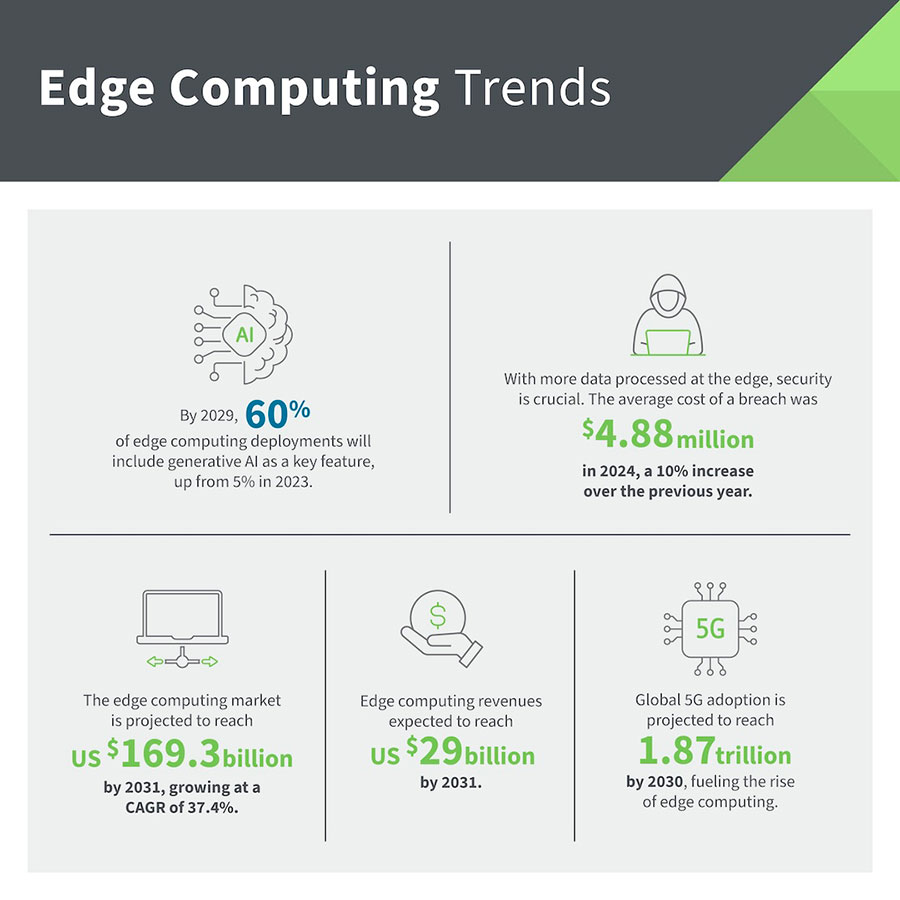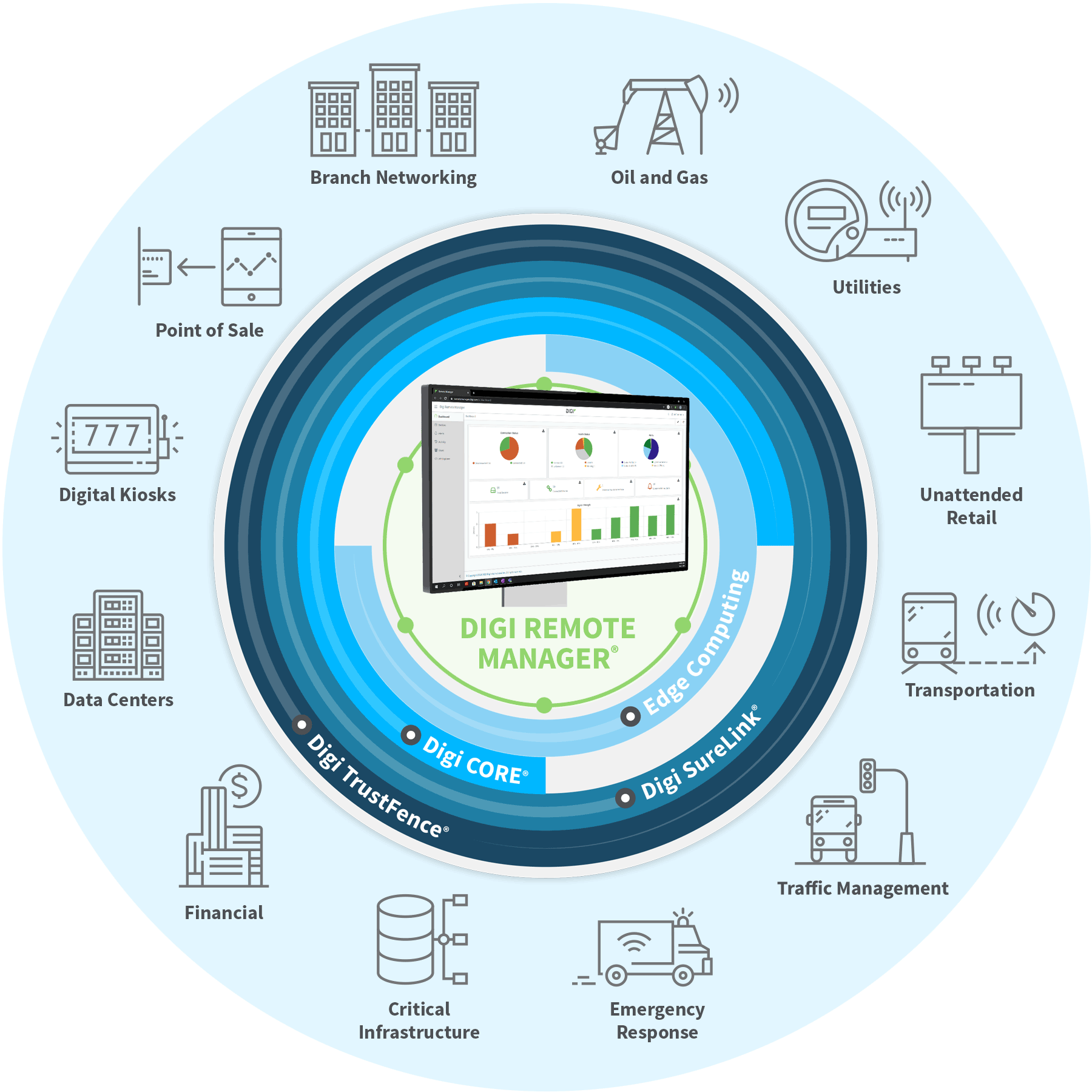The digital landscape continues to evolve at an unprecedented pace, with businesses seeking new ways to process data faster and closer to where it's generated. The capabilities of intelligent edge network devices are reducing latency and making real-time processing a reality. At the same time, industrial and commercial operations want rapid insights from the network edge. The result is a shift in
edge computing trends and digital transformation.
By shifting data storage and computation to the edge of networks, companies are discovering fresh opportunities to enhance performance, improve efficiency, and gain a competitive edge. Plus, with the rise of edge computing, cloud-based models are undergoing significant transformation.
Processing data closer to the source, especially in sectors like utilities, oil and gas and manufacturing, helps reduce the strain on centralized servers. This shift not only accelerates decision-making but also reduces bandwidth costs, making edge computing trends a focal point in today's technology landscape.

Why Edge Computing Trends Matter
The edge computing market is growing rapidly as more organizations across the industrial and commercial landscape — including utilities, oil and gas, and manufacturing automation — see the benefits of edge devices and real-time data processing. Straits Research estimates the market size was valued at USD 18.3 billion in 2022 and is expected to reach USD 112 billion by 2031, with a CAGR of 44.7%. This means that IoT providers have a ready audience if they can deliver solutions that provide the following:
- Rapid insights from the network edge
- Greater outcomes in terms of real-time edge processing
- Immediate notifications of system problems and data breaches
Industries that rely on speed, accuracy, and efficiency are turning to edge network devices as a way to enhance operations. Here are some examples:
- In the energy sector, utilities are turning to both edge computing technology and private networks to modernize grids, improve speed and reliability, and support predictive maintenance to reduce downtime.
- In healthcare, real-time patient monitoring systems must analyze data on the spot to make timely interventions.
- In manufacturing plants, edge computing is used to control machinery and automate processes, avoiding delays caused by sending data back and forth to the cloud. Ultimately, the ability to process data locally not only boosts performance but also ensures that systems remain operational even if connectivity to the cloud is lost.
As businesses continue to adopt emerging technologies like IoT and AI, the role of edge computing is becoming even more crucial. Edge computing trends drive innovation in sectors where rapid decision-making and real-time data analysis are critical. With the increasing demand for low-latency, high-efficiency systems, edge computing increasingly offers a methodology for companies to stay solve challenges and remain competitive in today’s fast-paced market.

Edge Computing Trends and Statistics
Edge computing trends provide great insight into where the market is going, and how industries are shifting to adopt new technology and take advantage of timesaving, cost-saving and latency reduction capabilities that were previously unavailable.
60% of Edge Computing Deployments Will Involve AI by 2029
 Edge AI is one of the most transformative developments in edge computing, enabling businesses to process data and run artificial intelligence algorithms at the network edge without sending it back to a central server. For industries that rely on immediate data processing, such as healthcare diagnostics or autonomous driving, edge AI brings unparalleled efficiency and accuracy. This approach significantly reduces latency and bandwidth costs, offering real-time insights directly at the point of data generation.
Edge AI is one of the most transformative developments in edge computing, enabling businesses to process data and run artificial intelligence algorithms at the network edge without sending it back to a central server. For industries that rely on immediate data processing, such as healthcare diagnostics or autonomous driving, edge AI brings unparalleled efficiency and accuracy. This approach significantly reduces latency and bandwidth costs, offering real-time insights directly at the point of data generation.
According to Gartner, by 2029, generative AI is projected to be part of 60% of all edge computing deployments, a sharp increase from just 5% in 2023. This shift highlights the growing importance of integrating AI at the edge, allowing companies to manage large-scale data processing while ensuring faster decision-making. As edge computing continues to evolve, the ability to combine AI with edge technology will create new possibilities for automation and data analytics, opening doors most businesses never thought possible.
Edge Computing: Enhancing Data Security
With more data processing occurring at the network edge, security is becoming a top priority for businesses. Edge environments present unique challenges, requiring advanced encryption, secure communication protocols, and AI-driven threat detection to protect sensitive information. As more companies adopt edge networking, the need for robust security measures to safeguard data against cyber threats grows exponentially.
According to IBM’s Cost of a Data Breach Report, in 2024, the average cost of a data breach reached $4.88 million globally, underscoring the importance of investing in edge security. Companies processing data at the edge must prioritize secure infrastructure to protect against evolving cyber threats. For example, the integration of AI in edge computing offers new ways to detect and mitigate potential risks, ensuring that data remains secure even in decentralized environments.
The Rise of Edge-as-a-Service
Edge-as-a-Service (EaaS) is revolutionizing how companies access and deploy edge network devices and connectivity solutions. Instead of investing in costly infrastructure, businesses can leverage EaaS to scale operations on demand. This model offers flexibility, allowing companies to pay for what they need when they need it, making edge computing more accessible to enterprises of all sizes.
Edge computing trends experts expect the market to grow at a compound annual growth rate (CAGR) of 37.4%, reaching an estimated value of $169.3 billion by 2031, according to a report by Meticulous Research. EaaS plays a significant role in this growth, allowing companies to integrate edge networking into their operations without the burden of heavy infrastructure investments. As the demand for real-time data processing rises, EaaS will continue to provide a cost-effective solution for businesses looking to stay competitive.
5G and Edge Computing Synergy
 The deployment of 5G technology creates an ideal environment for edge computing to flourish. With faster speeds and reduced latency, 5G networks enable real-time applications like augmented reality and autonomous vehicles to operate more effectively. The synergy between 5G and edge computing helps industries capitalize on the potential of real-time data processing, opening doors to innovations previously hindered by network limitations.
The deployment of 5G technology creates an ideal environment for edge computing to flourish. With faster speeds and reduced latency, 5G networks enable real-time applications like augmented reality and autonomous vehicles to operate more effectively. The synergy between 5G and edge computing helps industries capitalize on the potential of real-time data processing, opening doors to innovations previously hindered by network limitations.
5G adoption and edge computing are complementary technologies that drive significant advancements in data processing and connectivity. In fact, 5G edge computing is a key emerging trend. According to PatentPC, experts expect global 5G adoption to reach $1.87 trillion by 2030, growing at a 47.6% CAGR from 2022, fueling the growth of edge computing. This surge in 5G connectivity will enhance edge computing capabilities, allowing businesses to optimize operations and deliver advanced services. As 5G becomes more widespread, companies across an array of sectors (and in more physical locations) will increasingly adopt edge solutions to unlock the full potential of real-time data processing.
This shift towards edge processing is set to change the data management landscape, allowing enterprises to improve their operations, reduce costs, and deliver innovative solutions to their customers.
Edge Computing Spending and Revenue to Escalate
With the edge computing trends pointing to both growth and opportunity, the projected expenditures and revenues from those investments are impressive. The infrastructure to support the growth in the edge computing market spurred by advances in network speed and AI capabilities is massive, with technology investments in hardware, software and services expected to hit $378 billion by 2028, according to RT Insights.
And by the same token, RT Insights believes the product and service providers offering solutions and services to meet these needs will see $29 billion in revenue by 2031.
Transform Your Edge Computing Strategy with Digi
 At Digi, we lead the industry in delivering advanced edge computing, robust IoT device management, and secure connectivity solutions specifically designed to meet the dynamic demands of modern businesses. Our comprehensive portfolio empowers organizations to accelerate data processing, optimize network performance, and significantly enhance cybersecurity.
At Digi, we lead the industry in delivering advanced edge computing, robust IoT device management, and secure connectivity solutions specifically designed to meet the dynamic demands of modern businesses. Our comprehensive portfolio empowers organizations to accelerate data processing, optimize network performance, and significantly enhance cybersecurity.
Digi’s edge computing solutions — like the Digi IX40 5G cellular router, and the Digi IX30-0EG4 cellular router with Anterix support — enable data to be processed efficiently at the network edge, dramatically reducing latency and improving responsiveness. Coupled with the Digi Remote Manager® Platform, you gain full visibility and control of your device ecosystems, ensuring seamless operations, predictive maintenance, and simplified scalability.
Security is at the core of everything we do. Digi’s secure connectivity solutions utilize state-of-the-art encryption and authentication technologies to safeguard your critical data from edge to the cloud. Our experienced team supports you at every stage, from initial integration through ongoing optimization, guaranteeing your IoT deployments remain resilient and protected.
Stay ahead of your competition by upgrading your infrastructure with Digi’s trusted, innovative solutions. Together, we can transform your business’s capabilities, drive efficiency, and securely harness the full potential of edge computing and connectivity. Choose Digi and confidently step into the future of digital innovation.
FAQ: Edge Computing Trends in Industrial Applications
What are the latest trends in edge computing for industrial sectors?
Some key trends include:
- AI and machine learning at the edge: Incorporating AI algorithms directly at the edge allows for faster data analysis and automated decision-making without needing to send data to the cloud.
- 5G and edge computing integration: 5G networks provide the bandwidth and low latency required to support edge computing, enabling real-time processing and communication in remote industrial environments.
- Edge-to-cloud integration: While edge computing handles immediate processing, cloud services are used for long-term storage and complex analytics, creating a hybrid model that balances local and centralized computing.
- Security improvements: As more devices are connected at the edge, advanced security protocols are being implemented to protect data and prevent cyberattacks.
What are the challenges of implementing edge computing in industrial environments?
The challenges include:
- Infrastructure costs: Deploying edge computing involves investment in hardware, sensors, and network infrastructure.
- Data management: Handling the vast amount of data generated by edge devices can be challenging, especially when integrating with cloud systems.
- Security risks: With more devices connected at the edge, there’s an increased risk of cyber threats and breaches.
- Skill gaps: The need for skilled professionals to manage, deploy, and maintain edge solutions is critical, and there may be a shortage of such talent.
Digi supports industrial organizations in planning and deploying industrial edge solutions that integrate security, rapid configuration and deployment and remote management for ongoing visibility — strategies that help to reduce strain on industrial teams while improving operational efficiency.
How does edge computing help improve safety in industrial settings?
Edge computing can enhance safety by:
- Real-time monitoring: Continuous monitoring of equipment and processes can quickly identify safety hazards such as overheating or gas leaks, triggering alarms and automatic shutdowns.
- Remote management: Operators can monitor remote and hazardous sites without needing to be physically present, reducing the risk of human exposure to dangerous environments.
- Safety compliance: Edge computing can ensure compliance with safety regulations by continuously collecting and analyzing safety-related data.
What industries can benefit most from edge computing in industrial applications?
Industries that can benefit include:
- Energy and utilities: For smart grids, predictive maintenance, and real-time performance monitoring.
- Manufacturing: For process optimization, supply chain management, and automation.
- Transportation and logistics: To monitor vehicle health, optimize routes, and improve fleet management.
- Oil and gas: For remote monitoring of oil rigs and pipelines, and to enhance safety and efficiency.
- Healthcare: For real-time patient monitoring and medical equipment management.
How does edge computing affect data privacy and security in industrial settings?
Edge computing can improve data privacy and security by reducing the need to send sensitive data to centralized cloud servers. By keeping the data local, the risks associated with data breaches during transmission are minimized. However, robust security measures at the edge — such as encryption, secure authentication, and intrusion detection — are necessary to prevent unauthorized access.
How is edge computing transforming utilities?
In utilities, edge computing enhances operations by enabling real-time monitoring and automation. It helps with:
- Predictive maintenance: Monitoring equipment health at remote sites and forecasting potential failures before they occur.
- Smart grid management: Collecting and processing data from sensors to optimize energy distribution, detect faults, and manage loads more efficiently.
- Energy consumption analysis: Analyzing real-time data from meters to optimize energy usage and reduce costs.
What role does edge computing play in manufacturing?
Edge computing in manufacturing helps optimize production processes by enabling:
- Real-time quality control: Sensors on production lines can detect anomalies and defects instantly, allowing for corrective actions.
- Predictive maintenance: By monitoring equipment conditions, edge computing predicts potential failures, reducing downtime.
- Supply chain optimization: Edge devices track inventory in real-time, improving logistics and inventory management.
- Process optimization: Data from machines is analyzed locally to improve efficiency, minimize waste, and reduce energy consumption.
How do edge computing solutions improve operational efficiency in manufacturing?
By processing data locally, edge computing helps manufacturers:
- Reduce latency: Real-time data processing eliminates delays, enabling quick decision-making and faster response times.
- Minimize downtime: Predictive maintenance powered by edge analytics reduces the chances of unplanned downtime, saving costs and improving productivity.
- Enhance automation: Local processing enables machines to communicate and adapt to changes without human intervention, streamlining operations.
What’s the future of edge computing in industrial applications?
The future of edge computing in industrial applications looks promising, with ongoing advancements in AI, machine learning, and 5G connectivity. Edge computing will continue to evolve with:
- Wider adoption of AI-powered edge devices to automate complex decision-making.
- Integration of 5G for faster, more reliable communication in industrial settings.
- More advanced security protocols to protect critical data and systems.
- Greater scalability, with edge devices being deployed across diverse industries.
As industries move towards digital transformation, edge computing will play a critical role in making operations more efficient, secure, and responsive to changes in real time.
This FAQ provides a general overview of the trends and benefits of edge computing in industrial sectors. As technology continues to evolve, more innovative applications are likely to emerge, making edge computing an integral part of future industrial strategies.
Next Steps